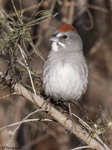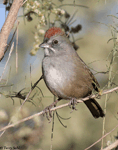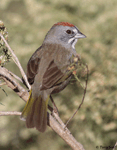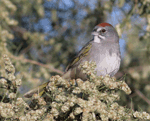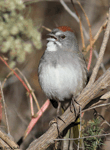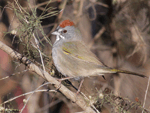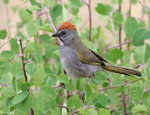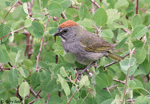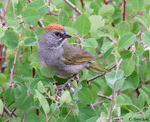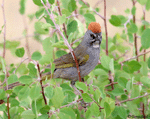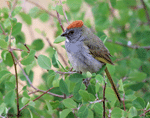| Length: 7.25 inches | Wingspan: 10 inches | Seasonality: Rare Visitor |
| ID Keys: Gray face and breast with white throat, reddish cap, olive-green upperparts and tail | ||
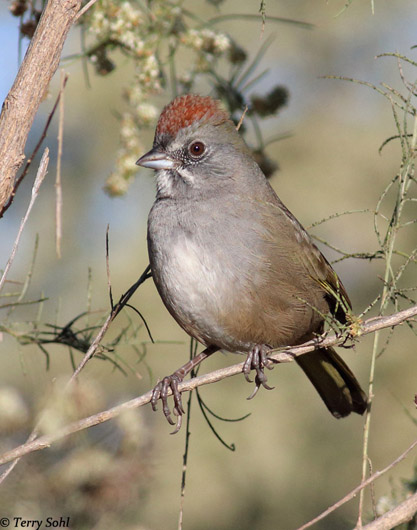 The Green-tailed Towhee is
a bird of mountains of the West in summer, where they are often first noticed
when strange catlike mewing is heard from dense shrubbery. Their behavior
is very similar to other Towhees, in that they prefer to remain low in the
vegetation and will often scratch at leaf-litter in an attempt to find
food. They are only rare visitors to South Dakota, although stray migrants
do show up as far east as the Atlantic Coast every fall.
The Green-tailed Towhee is
a bird of mountains of the West in summer, where they are often first noticed
when strange catlike mewing is heard from dense shrubbery. Their behavior
is very similar to other Towhees, in that they prefer to remain low in the
vegetation and will often scratch at leaf-litter in an attempt to find
food. They are only rare visitors to South Dakota, although stray migrants
do show up as far east as the Atlantic Coast every fall.
Habitat: Found in a variety of semi-open habitats, primarily in the mountains of the West. Preferred habitats are areas of low dense shrubby cover with a few scattered taller trees. They are a species that can tolerate a human presence, and sometimes benefit by the low second-growth vegetation that grows after the clearing of a forest.
Diet: Primarily feeds on insects and seeds. Will also occasionally feed on fruits and berries.
Behavior: Primarily forages on the ground under vegetative cover. They will often scratch at leaf litter in search of food like the other Towhees. Those that do come to feeders generally remain on the ground to feed on fallen seeds and grains.
Breeding: The nest of a Green-tailed Towhee is a cup sticks, bark, and herbaceous plant stems, lined with finer grasses, hair, and small rootlets. The female alone builds the nest, placing it low in dense vegetation such as a shrub or small tree. She lays between 2 and 5 eggs, and she alone incubates them. The young hatch after 12-14 days, and fledge from the nest after another 12-14 days.
Song: A series of chip notes evolving into a trill. Click here to hear the song of a Green-tailed Towhee (audio courtesy of Lance A.M. Benner). The typical call is an ascending mewing somewhat reminiscent of a Gray Catbird. Click here to hear the call of a Green-tailed Towhee (audio courtesy of Jeremy Minns).
Migration: Summers throughout much of the inland West. Winters in extreme southwestern Texas, extreme southern Arizona and New Mexico, and in Mexico.
Interactive eBird Map: Click here to access an interactive eBird map of Green-tailed Towhee sightings
Similar Species: Olive Sparrow (only normally found in the Rio Grande Valley in the United States).
Bird Feeders: Will attend feeders for various seeds and grains.
Conservation Status: Numbers are generally stable, and they are found over a very wide geographic area. They've adapted fairly well to a human presence, and no serious threats to their populations are noted. The IUCN considers the Green-tailed Towhee to be a species of "least concern".
Further Information: 1) Patuxent Bird Identification InfoCenter, Green-tailed Towhee
2) Audubon Field Guide - Green-tailed Towhee
3) WhatBird - Green-tailed Towhee
Photo Information: Photo taken on November 11th, 2015 - Tanque Verde Wash, Tucson, Arizona - Terry Sohl
| Click on the map below for a higher-resolution view |
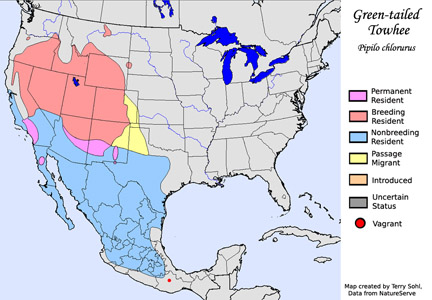 |
| South Dakota Status: Rare visitor, with only a handful of records in the state. |
Additional Green-tailed Towhee Photos

